The hidden risks of improper metal panel field cuts
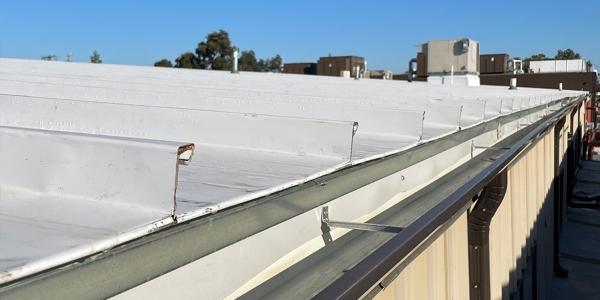
By AEP Span.
Why improper cuts could cost you more than just an imperfect edge.
When it comes to metal roofing and siding, every cut counts. While factory cuts offer precision, the reality on the ground often demands adjustments — quick field cuts for complex transitions, roof penetrations, or awkward angles. But a misstep here, a poorly chosen tool there and you could be left with more than just jagged edges. We're talking about compromised aesthetics, costly corrosion and even the potential loss of material warranties. Discover with us here at AEP Span, why choosing the right method and tools for field-cutting metal panels is crucial and what you need to know to avoid the pitfalls of improper cuts.
The importance of proper field cutting metal panels

Field cuts are often necessary, as factory cuts may not work or be practical for certain transitions or roof conditions, such as hips, valleys, roof penetrations or a variety of other conditions that can exist on a roof. While factory cuts are precise, on-site cuts and adjustments are often required for proper installation. Improper field cutting, however, can leave exposed edges susceptible to unsightly workmanship or worse yet, corrosion at the cut edge of the material.
Risks of sawing and abrasive cutting


Factory cuts use specialized shearing processes, akin to the action of scissors, to ensure clean and precise edges. This method helps maintain the integrity of the protective coatings, such as ZINCALUME® which act as sacrificial layers to prevent corrosion. In contrast, sawing or abrasive cutting can leave jagged edges and produce heat that damages these coatings, leading to potential corrosion issues.
Abrasive cutting generates “swarf” (fine metallic filings and fragments). These tiny particles, often invisible to the naked eye, are unintentionally left on the metal surface. If left unchecked, they can corrode and cause rust stains, leading to permanent visual deformities on the metal product.
The two photos on the left show a metal panel being field cut using a grinding disk. The second photo shows the swarf left behind from a grinding disk on the metal panels that have corroded and stained the metal panels.
Recommended tools for field cutting
There are several reasons factory-produced panels require cutting on a job site. To maintain the quality and durability of AEP Span metal roofing & siding panels, we propose the following tools for field cutting:
Hand tools
The following hand tools are preferred as they utilize a clean shearing motion.
Aviation snips: For precise cuts, available in left, right and straight cutting versions.
Sheet metal shears: A heavy-duty, long-handled pair of metal cutting scissors with short blades.
Guillotine-style shearing blades: The most popular is a portable hinged device manufactured by Swenson Shear. It is commonly used to field cut corrugated or trapezoidal ribbed panels at right angles to the ribs. Swenson Shear also manufactures a portable field table for notching standing seam panels.

Aviation Snips
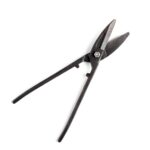
Sheet Metal Shears

Guillotine-Style Shearing Blades
Electrical power tools
Nibblers: Handheld oscillating punch-and-die tool that removes small pieces of metal. Note, when using this tool, it’s difficult to cut in a straight line and can be challenging to cut up-and-over standing seam or trapezoidal ribs.
Power shears: Electric scissors that produce clean cuts with minimal burrs. This is a good tool to cut parallel to ribs or for cutting the flat pan of a standing seam panel, but it’s difficult to cut across a panel.
Using high-quality tools helps ensure clean cuts and reduces the risk of corrosion. To achieve the best results, tools should always be kept sharp and well-maintained. Improperly cutting prefinished panels on a job site can create severe performance issues. If an improper cut edge is exposed to weather, the cut panels can create corrosion and finish deficiencies that will compromise the material and paint finish warranties.
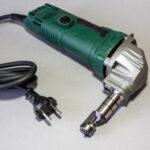
Nibbler
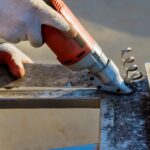
Power Shears
The misunderstood aspect of cut edge protection
Metal roofing installers and users do not need to be concerned about corrosion at cut edges when field-cutting metal panels correctly. While the edge is exposed, the base carbon steel is encased by a metallic coating on both sides. Over time, galvanic action causes zinc compounds in the coating to automatically build up at any cut edges to prevent corrosion. Additionally, when metal is cut in a shearing action, small amounts of the metallic coating can be folded over the exposed base metal to provide additional protection. For particularly harsh environments, consider hemming panel edges to conceal and shield them from exposure. Irregular cutting motions such as sawing or abrasive cutting may introduce impurities to the cut edge or create inconsistent pathways for the metallic coating to encase the cut edge, increasing the risk of corrosion.
The science behind self-healing properties
In service, galvanic action causes zinc compounds to automatically build up at any cut edges or scratches through an electrolytic reaction when water or moisture is present. This process slows the rate at which the surrounding coating is consumed around damaged areas, sometimes referred to as the “self-healing” property of ZINCALUME® coatings.

Galvanized

ZINCALUME®
The images above show a corrosion comparison of a field cut metal panel drip edge at 20 years of service life. Both products are painted and located in an acid-rain environment. Note how the ZINCALUME® product has slowed the spread of corrosion. Images courtesy of Steelscape.
Superior cut edge protection in severe environments
In more severe environments, ZINCALUME® offers superior cut-edge protection. Unlike galvanized coatings, which are purely sacrificial, zinc and aluminum are included. While zinc will corrode preferentially, aluminum acts as a protective barrier, slowing the spread of corrosion and the rate at which this coating is consumed. For additional protection, particularly in harsh environments, consider hemming panel edges to conceal and shield them from exposure.

Are cut and exposed edges a source of corrosion?
The short answer is no. Field cutting metal panels with exposed edges are not a significant source of corrosion. However, this depends on installation and environmental factors. In general, several reasons underpin why exposed edges are not a source of significant concern:
- The zinc in the ZINCALUME® coating acts as a sacrificial layer.
- The self-healing properties of the coating slow down the rate of corrosion.
- Additional protective measures, such as hemming, can be employed in extreme environments.
In summary
In summary, following proper field cutting techniques and using recommended tools will help ensure that your AEP Span metal panels perform as intended and maintain their aesthetic and functional qualities over time.
Original article and photo source: AEP Span
Learn more about AEP Span in their Coffee Shop Directory or visit www.aepspan.com.
About AEP Span
AEP Span is a premier manufacturer of commercial metal roofing and siding products, offering an unrivaled commitment to the success of contractors. AEP Span offers a broad portfolio of extensively tested and accredited products (including Building Code and LEED accreditations).
AEP Span offers extensive support to contractors, including technical and architect support, detailed installation resources, weathertight warranties, and estimation services.
Recommended For You
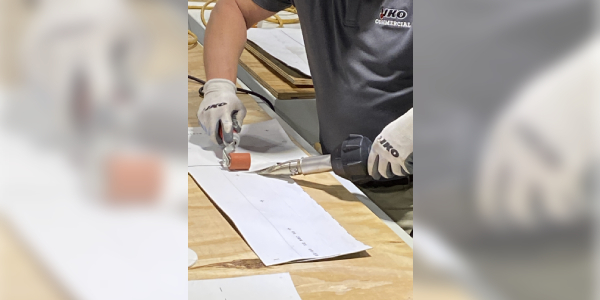
IKO Commercial showcases industry-leading products; introduces the soon-to-be-launched IKO Rooftop Access App at IRE 2025
Read More ...
CoreLogic Risk Analysis Shows Hurricane Delta Threatens 293,685 Homes with Storm Surge Damage
Read More ...
Western States Roofing Contractors Association Year in Review 2016
Read More ...

















Comments
Leave a Reply
Have an account? Login to leave a comment!
Sign In